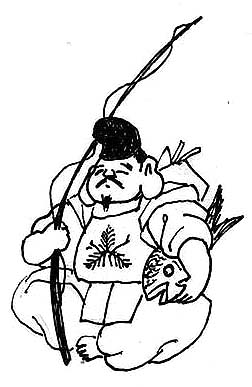|
||
 |
||
1@One of the seven gods of good fortune *shichifukujin ΅_. Ebisu is regarded as the tutelary deity of all occupations, but especially of fishing, farming and commerce. The main attributes of Ebisu are his fishing rod, held in his right hand or over his right shoulder, and a freshly caught, large red snapper or sea bream (tai β, a symbol of good fortune) under his left arm. He is a plump figure with a broadly grinning face, usually shown sitting on a rock. He may wear a kimono ¨ and divided skirt hakama Ρ, or sashinuki wΡ, a type of Heian period hakama gathered in at the ankles, or sometimes kariginu λί, the ancient hunting robes which became the ordinary apparel of Heian period courtiers. On his head, he wears a tall, pointed cap folded in the middle called kazaori eboshi άGXq. His happy expression and attributes of prosperity make him a popular god among merchants. Ebisu is frequently paired with the god *Daikokuten εV, who is also one of the Seven Gods of Good Fortune. The two gods are often enshrined in the kitchen, especially in farming communities. Worship of Ebisu became very popular during the Edo period, when Ebisu dolls were mass-produced and sold throughout the countryside by traveling Ebisu puppeteers (ebisumawashi bδ{ρ or ebisukaki Ξδl) mainly from Nishinomiya Ό{ in Hyougo prefecture. Dolls or portraits were used by believers at festival rites ebisukou Ξqu, held on October 20th (or in January in some regions) to celebrate Ebisu and pray for prosperity.
Ebisu, a popular subject painted by various artists of the Edo period including Kanou Tan'yuu λμTH (1602-74) and Ogata Kourin φ`υΤ (1659-1716), remains popular to this day. In *ootsu-e εΓG, Ebisu and Daikokuten are sometimes caricatured as two figures engaged in a bout of sumou o wrestling.
The name Ebisu is derived from the term for foreigner or barbarian and thought to reflect the early worship of deities bringing desired skills from distant lands.
2@The god of commerce, represented in kyougen ΆΎ plays by a masked figure *kyougenmen ΆΎΚ. The ebisu mask has a generous, laughing expression; his eyes are narrowed, forehead gently furrowed, and mouth wide open in a broad smile. His moustache and eyebrows are painted in fine black lines. Ebisu appears in celebratory kyougen plays such as EBISU DAIKOKU bδ{ε and EBISU BISHAMON bδ{ωΉε. The ebisu mask was also frequently used to represent the god of happiness *fuku-no-kami Μ_, the main character in the play FUKU-NO-KAMI.

@
(C)2001 Japanese Architecture and Art Net Users System.@No reproduction or republication without written permission.
fΪΜeLXgEΚ^ECXgΘΗASΔΜRecΜ³f‘»E]ΪπΦΆά·B

